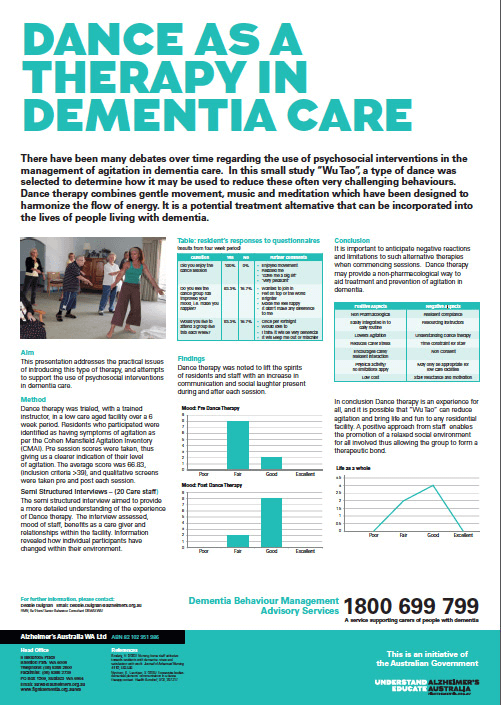Research
Exploring dance as a therapy for symptoms and social interaction in a dementia care unit
Author:
Debbie Duignan BA Hons, RMN, Lynne Hedley RN, BSc Health services ¹, Rachael Milverton²
¹ Dementia Behaviour Management Advisory Service (DBMAS), Alzheimer’s Australia WA.
²4th year undergraduate BSc (Occupational Therapy), Curtin University of Technology.
Abstract:
D Duignan et al, (2009), Dance as a therapy in dementia Care “Wu Tao”.
There have been many debates over time regarding the use of some of the atypical antipsychotic drugs in the management of agitation in dementia care. Much research has been conducted in the area surrounding psycho social interventions, with dance therapy being one of them. We will suggest that a mixture of dance therapy and meditation is a treatment that can be incorporated in to the lives of older people, with benefits that can enhance the lives of all involved.
This article addresses the practical issues of Wu Tao, and attempts to break down the beliefs that psycho social interventions are not effective in Dementia Care.
Read more
AIMS/OBJECTIVES
The overall aim of this project is to evaluate the usefulness of Wu Tao dance therapy for people with dementia living in low care facilities, and assessing the impact of agitation. The aim would be to include care staff at a low care facility, within the dance group and monitor carer stress in relation to working with clients whom experience high levels of agitation.
The key objectives are to:
RESULTS
A post CMAI measure was used following the final Wu Tao session, to identify any changes. The result showed that the average score was now 60.67, presenting a decline in agitation of 6.16 (See table 1 for all CMAI scores).
Table 1: Cohen-Mansfield Agitation Inventory (CMAI) – Results
Table 3: Staff responses to question
CONCLUSION
Initially many of the residential staff were hesitant towards Wu Tao as a therapy. Many did not believe that this could reduce agitation in residents whom have had a long standing history of dementia behavioral disturbances.
However following education sessions surrounding dance therapy and its positive impact, staff were willing to be involved in the Wu Tao trial. Many of the staff stated they were pleasantly surprised by the relaxing and enjoyable experience. By the conclusion of the first session, Wu Tao was considered to be very well received by both staff and residents. Many staff reported that they were eager to continue the dance sessions outside of their work environment.
Staff at the facility noted that the group dynamics had changed significantly, becoming more positive amongst both residents and staff. A positive working environment is critical in working in dementia care, and this highlights the value of Wu Tao and dance in enabling expression both verbally and non-verbally.
To enable dance sessions to be conducted within a facility environment, education and support form care staff is of paramount importance, the positive approach from staff helps to promote a relaxed and social environment for all involved allowing the group to form a therapeutic bond.
It is important to anticipate negative reactions to such alternative therapies when commencing such sessions. Negative reactions could be due to a lack of existing or research relating to dance therapy within the daily practices of residential facilities, along with stereotypic views towards alternative forms of treatment (Norman H 1999)
Symptoms of agitation make living with dementia more difficult for both clients and those who support them. From a subjective point of view it seems that Wu Tao has possibly improved the lives of those living with dementia.
u Tao may provide a non-pharmacological way to aid treatment and prevention of agitation in dementia, this may not only help integrate staff and residents but also lift the spirits of those involved.
In conclusion Wu Tao is an experience for all, and it is possible that “Wu Tao” can reduce agitation and bring life and fun to any residential facility.
ACKNOWLEDGEMENTS
I would like to acknowledge the facility of Brightwater care group in Joondalup for taking part in this trial, and for their dedication and support of older adults with Dementia. Without this facility and their involvement, this project would not have been possible.
Also thank you to Kaye and Michelle, the Wu Tao dance instructors, for their patience and enthusiasm in this trial.
Further information regarding Wu Tao in dementia (Wu Tao Wisdom) can be found at www.wutaodance.com
References
- Lift mood.
- Create a therapeutic bond between staff and resident.
- Create a fun environment.
- Reduce carer stress and increase carer confidence.
- Examine and measure changes in client agitation.
- Encourage friendships to form between residents.
- To up skill staff within Wu Tao dance therapy
- To continue dance therapy within the facility
|
Positive Aspects |
Negative Aspects |
| Non Pharmacological | Resident Participation |
| Easily integrated in to daily routine | Sourcing instructors |
| Lowers agitation | Understanding Wu Tao |
| Reduces Carer Stress | Time constraint for staff |
| Encourages carer/resident interaction | Short trial |
| Physical activity/no limitations apply | May only be appropriate for low to moderate levels of dementia (further research will need to be conducted) |
| Low cost | Staff reluctance and motivation |
| Client |
Initial score (05.02.09) |
Follow-up score (date) |
|
1 |
50 |
55 |
|
2 |
83 |
62 |
|
3 |
89 |
79 |
|
4 |
55 |
70 |
|
5 |
69 |
49 |
|
6 |
55 |
49 |
|
Total |
401 |
364 |
|
Average |
66.83 |
60.67 |
A reduction of 6.16 between pre and post scores
As indicated from the table above 4 out of the 6 participants scores reduced, indicating that some reduction in agitation was noted, 2 participants scores however increased. Both residents with increased scores had medication changes throughout the trial period; this may have contributed to their increase in scores. Questionnaires were also collected over the 4 week trial to monitor the responses of residents and staff to the intervention. The table below represents the changes observed and described by both residents and staff from the initial and subsequent Wu Tao sessions. All of the participants in the dance group, which included residents and staff, indicated that Wu Tao was a pleasurable and enjoyable therapy. Many felt that this could be incorporated in to their weekly activity programme, and given the correct training could be an activity where both staff and residents could benefit. As anticipated, some residents did have difficulty orienting themselves adequately to the instructions. This was mainly left and right side orientation, which is however a minor difficulty as the dance is still able to be completed. The aims of the sessions were met as follows:- Wu Tao was noted to lift the spirits of both residents and staff, through the increase in communication and social laughter present during and after each session.
- Staff were observed to interact with one another more easily and a greater level of relaxation was noted.
- A therapeutic bond between staff and residents developed. One resident when asked “what did you think about the staff joining your group?” replied “It teaches them to be like us”. It was noted from participants that much laughter and verbal interaction was evident.
- It was indicated by staff that this form of therapy would be beneficial to their own well being. One member of staff stated that it provides a “lighter side of the work”; this was also indicated by the number of requests from staff to attend out of work classes.
- Agitation, through the results of the CMAI was shown to be reduced for 4 of the residents.
- The facility aims to continue the dance therapy, provided funding constraints enable.
|
Question |
Yes |
No |
Further comments |
| Did you enjoy the dance session | 100% | 0% |
|
| Do you feel the dance group has improved your mood, i.e. made you happier? | 83.3% | 16.7% |
|
| Do you feel the dance has helped you? How? | 83.3% | 16.7% |
|
| Would you like to attend a group like this each week? | 83.3% | 16.7% |
|
| Did you think it was good about the staff joining in your group? | 100% |
|
|
| Did the dance group make you feel differently? | 91% | 9% |
|
| Question |
Yes |
No |
Further comments |
| Do you feel that the Wu Tao dance group was beneficial to residents and staff? If so how? | 100% |
|
|
| Do you feel it has increased your job satisfaction? | 91.7% | 8.3% |
|
| Have you noticed any relationship changes in the group? | 58.3% | 41.6% |
|
| Did you notice any changes in resident’s behaviours throughout or following the sessions, if so what did you notice? | 83.3% | 16.7% |
|
| Do you feel these groups could be introduced into your facility by staff? And if so would it be useful to continue? | 100% |
|
|
| Did you attend the dance session? | 100% | ||
| Do you feel that relationships between residents in the group may have changed? In what ways? | 75% | 25% |
|
| Have you noticed changes in the way that residents who participated in Wu Tao react differently to those who didn’t? | 50% | 50% |
|
| Do you feel that a weekly dance group involving staff and residents could increase your own well being? If so how? | 100% |
|
Benner, P., & Wrubel, J. (1989). The primacy of caring. Menlo Park, Ca: Addison-Wesley.
Boller, F., Verny, M., Hugonot-Diener, L., & Saxton, J. (2002). Clinical features and assessment of severe dementia: A review. European Journal of Neurology, 9 (2), 125-136.
Brodaty, H. (2003). Nursing home staff attitudes towards residents with dementia: strain and satisfaction with work. Journal of Advanced Nursing 44 (6), 583-590.
Camp, C. J., Cohen-Mansfield, J., & Capezuti, E. A. (2002). Mental health services in nursing homes: Use of no pharmacologic interventions among nursing home residents with dementia. Psychiatric Services, 53, 1397-1404.
Chou, S, Boldy, D. P., & Lee, A. H. (2002). Staff satisfaction and its components in residential aged care. International Journal for Quality in Health Care, 14 (3), 207-217.
Coaten, R. (2001). Exploring reminiscence through dance and movement. Journal of Dementia Care, 9, 19-22.
Cohen-Mansfield, J. et al (1989). A description of agitation in a nursing home. Journal of Gerontology, 44 (?), 77-84.
Douglas, S. et al (2004). Non-pharmacological interventions in dementia. Advanced Psychiatry Treatment, 10 (3), 171-177.
Hokkanen, L., Rantale, L., Remes, A. M., Härkönen, B., Petteri, V., & Winblad, I. (2003). Dance and movement therapeutic methods in management of dementia: A randomized controlled study. Journal of the American Geriatrics Society, 56 (4), 771-772.
Locke, M. (2008). Wu Tao: the dancing way. (Available from Wu Tao head office, 179 Healy Road, Hamilton Hill, WA 6163).
Marshall, M., & Archibald, C. (1998). Long-stay care for people with dementia: recent innovations. Clinical Gerontology, 8, 331-343.
Normann H (1999) Alternative treatments in dementia
Journal of clinical nursing 8(4); 353-359, July
Nystrom, K., Lauritzen, S. (2005). Expressive bodies: demented persons’ communication in a dance therapy context. Health (London), 9 (3), 297-317.
Smith, P. (1992). The emotional labour of nursing. Macmillan: Basingstoke.
Snowdon, J, (1993). Mental health in nursing homes. Perspectives on the use of medication. Drugs and Aging, 3 (2), 122-130.
Sultzer, D. L. (2003). Psychosis and antipsychotic medications in Alzheimer’s disease: clinical management and research perspectives. Dementia and Geriatric Cognitive Disorders, 17 (1-2), 78-90.
As seen on Today Tonight

